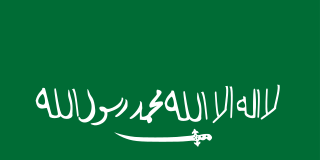
The history of Saudi Arabia as a nation state began with the emergence of the Al Saud dynasty in central Arabia in 1727 and the subsequent establishment of the Emirate of Diriyah. Pre-Islamic Arabia, the territory that constitutes modern Saudi Arabia, was the site of several ancient cultures and civilizations; the prehistory of Saudi Arabia shows some of the earliest traces of human activity in the world.

Wahhabism is a reformist movement within Sunni Islam, based on the teachings of 18th century Hanbali cleric Muhammad ibn 'Abd al-Wahhab. The term "Wahhabism" is primarily an exonym; it was not used by Ibn 'Abd al-Wahhab himself or adherents to the movement, who typically prefer to be called "Salafi". The movement's early followers referred to themselves as Muwahhidun derived from the term Tawhid. The term "Wahhabism" has also been used as a sectarian and Islamophobic slur.

Najd is the geographic center of Saudi Arabia, accounting for about a third of the country's modern population. It is the home of the House of Saud, from which they pursued the unification of Saudi Arabia since the time of the Emirate of Diriyah.

The Hejaz is a region which includes the majority of the west of Saudi Arabia, which includes the cities of Mecca, Medina, Jeddah, Tabuk, Yanbu, Taif and Baljurashi. It is thus known as the "Western Province", and is bordered in the west by the Red Sea, in the north by Jordan, in the east by the Najd, and in the south by the Region of 'Asir. It is the most cosmopolitan region in the Arabian Peninsula. Its largest city is Jeddah, which is the second largest city in Saudi Arabia, with Mecca and Medina respectively being the fourth and fifth largest cities in the country.

The Kingdom of Saudi Arabia is an Islamic absolute monarchy in which Sunni Islam is the official state religion based on firm Sharia law. Non-Muslims must practice their religion in private and are vulnerable to discrimination and arrest. While no law requires all citizens to be Muslim, non-Muslim foreigners attempting to acquire Saudi Arabian nationality must convert to Islam. Children born to Muslim fathers are by law deemed Muslim, and conversion from Islam to another religion is considered apostasy and punishable by death. Blasphemy against Sunni Islam is also punishable by death, but the more common penalty is a long prison sentence; there have been 'no confirmed reports of executions for either apostasy or blasphemy' in the 21st century.
The Ottoman/Egyptian-Wahhabi War also known as the Ottoman/Egyptian-Saudi War (1811–1818) was fought from early 1811 to 1818, between the Ottoman Empire and the Emirate of Diriyah, the First Saudi State, resulting in the destruction of the latter.

The Emirate of Diriyah, also known as the First Saudi State, was established in February 1727. In 1744, the emir of a Najdi town called Diriyah, Muhammad bin Saud, and the religious leader Muhammad ibn Abd al-Wahhab formed an alliance to found a socio-religious reform movement to unify the many states of the Arabian Peninsula.

Salafi Islam is the state religion of Saudi Arabia. The connection between Islam and modern-day Saudi Arabia is uniquely strong. The kingdom is called the "home of Islam"; the kingdom is also the birthplace of the Prophet Muhammad, with all territories of Saudi Arabia and the Arabian Peninsula being united and ruled by him. It is the location of the cities of Mecca and Medina, where Muhammad, the messenger of the Islamic faith, lived and died. The kingdom attracts millions of Muslim Hajj pilgrims annually, and thousands of clerics and students who come from across the Muslim world to study. The official title of the King of Saudi Arabia is "Custodian of the Two Holy Mosques"—the two being Al-Masjid al-Haram in Mecca and Al-Masjid al-Nabawi in Medina—which are considered the holiest in Islam.

The Ikhwan, commonly known as Ikhwan man ata'a Allah, was a religious militia made up of traditionally nomadic tribesmen which formed a significant military force of the ruler Ibn Saud and played an important role in establishing him as ruler of most of the Arabian Peninsula in the Kingdom of Saudi Arabia.

Harb is a predominantly Arab tribe in the Arabian peninsula. It is originally a Qahtanite tribe. Some sources on Arab tribes' genealogy state that the great-grandfather of the Harb tribe is Harb ibn Saad ibn Saad ibn Khawlan ibn Amr ibn Qadha'ah ibn Himyar ibn Qahtan. Harb tribal lands extend from the Red Sea coast in Tihamah to the heart of Najd in the central region of Saudi Arabia, and from North the Harbi lands extend from Madinah to Al Qunfudhah in the south. The tribe's reach extends to other countries like Kuwait, Iraq, Bahrain and UAE.
The article describes the state of race relations and racism in the Middle East. Racism is widely condemned throughout the world, with 174 states parties to the International Convention on the Elimination of All Forms of Racial Discrimination by April 8, 2011. In different countries, the forms that racism takes may be different for historic, cultural, religious, economic or demographic reasons.

The Unification of Saudi Arabia was a military and political campaign in which the various tribes, sheikhdoms, city-states, emirates, and kingdoms of most of the central Arabian Peninsula were conquered by the House of Saud, or Al Saud. Unification started in 1902 and continued until 1932, when the Kingdom of Saudi Arabia was proclaimed under the leadership of Abdulaziz, known in the West as Ibn Saud, creating what is sometimes referred to as the Third Saudi State, to differentiate it from the Emirate of Diriyah, the First Saudi State and the Emirate of Nejd, the Second Saudi State, also House of Saud states.

The destruction of heritage sites associated with early Islam is an ongoing phenomenon that has occurred mainly in the Hejaz region of western Saudi Arabia, particularly around the two holiest cities of Islam, Mecca and Medina. The demolition has focused on mosques, burial sites, homes and historical locations associated with the Islamic prophet Muhammad, his companions, and many of the founding personalities of early Islamic history by the Saudi government. In Saudi Arabia, many of the demolitions have officially been part of the continued expansion of the Masjid al-Haram at Mecca and the Prophet's Mosque in Medina and their auxiliary service facilities in order to accommodate the ever-increasing number of Muslims performing the pilgrimage (hajj).
The Saudi government does not conduct a census on religion or ethnicity, but some sources estimate the Shiite population in Saudi Arabia to make up around 10–15% of the approximately 23 million natives of Saudi Arabia. The modern Kingdom of Saudi Arabia was formed in 1932 by the House of Saud, who are followers of a movement within Sunni Islam known as Wahhabism. Followers of the Wahhabite mission—who dominate religious institutions, courts and education of the kingdom—believe that "Muslims should return to the interpretation of Islam found in the classical texts, the Quran and the Sunnah." They also believe that "Muslims who seek intercession from holy men, such as the imams revered by Shiites, are not 'true' Muslims."
Islam is the state religion of Saudi Arabia.

Saudis or Saudi Arabians are the citizens and nationals of Kingdom of Saudi Arabia. They are mainly composed of Arabs and live in the five historical Regions: Najd, Hejaz, Asir, Tihamah and Al-Ahsa; the regions which the Kingdom of Saudi Arabia was founded on or what was formerly known as the Kingdom of Hejaz and Nejd in the Arabian Peninsula. Saudis speak one of the dialects of Peninsular Arabic, including the Hejazi, Najdi, Gulf and Southern Arabic dialects, as a mother tongue.

Anti-Sunnism is hatred of, prejudice against, discrimination against, persecution of, and violence against Sunni Muslims.
The Qatif and Dammam mosque bombings occurred on 22 and 29 May 2015. On Friday May 22, a suicide bomber attacked the Shia "Imam Ali ibn Abi Talib Mosque" situated in Qudeih village of Qatif city in Eastern Province, Saudi Arabia. The Islamic State of Iraq and Syria claimed responsibility for the blast, which killed at least 21 people. The event is the second deadly attack against Shia in six months.

Al-Baqi cemetery, the oldest and one of the two most important Islamic graveyards located in Medina, in current-day Saudi Arabia, was demolished in 1806 and, following reconstruction in the mid-19th century, was destroyed again in 1925 or 1926. An alliance of the House of Saud and the followers of the Wahhabi movement known as the Emirate of Diriyah carried out the first demolition. The Sultanate of Nejd, also ruled by the House of Saud and followers of Wahhabism, carried out the second. In both cases, the actors were motivated by the Wahhabi interpretation of Islam, which prohibits the building of monuments on graves.

The Wahhabi movement started as a revivalist and reform movement in the Arabian Peninsula during the early 18th century, whose adherents described themselves as "Muwahhidun" (Unitarians). A young Hanbali cleric named Muhammad ibn ʿAbd al-Wahhab, the leader of the Muwahhidun and eponym of the Wahhabi movement, called upon his disciples to denounce certain beliefs and practices associated with cult of saints as idolatrous impurities and innovations in Islam (bid'ah). His movement emphasized adherence to the Quran and hadith, and advocated the use of ijtihad. Eventually, Ibn 'Abd al-Wahhab formed a pact with a local leader, Muhammad bin Saud, offering political obedience and promising that protection and propagation of the Wahhabi movement meant "power and glory" and rule of "lands and men".















